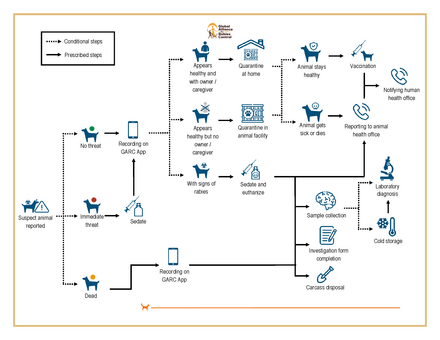Unlocking professional expertise: GARC's protocol for investigating potentially rabid dogs

You are likely aware that GARC is a science-led organization, that bases all our approaches, resources and tools off of strong scientific evidence. This is evident in our free online education courses, our surveillance tools and our education resources that can be downloaded from our site. While many are familiar with GARC's overarching mission and public-facing initiatives, a lesser-known treasure trove lies in the exclusive scientific protocols that we offer – meticulously crafted to address the diverse challenges encountered by professionals in the field.
In the relentless battle against rabies, every stakeholder plays a crucial role. From community members to animal health professionals, each person's contribution is pivotal in achieving the shared goal of rabies elimination. However, navigating the complexities of rabies management requires not just dedication, but also access to specialized knowledge and protocols tailored to specific professional domains. It is for this reason that GARC has developed (and continues to develop) protocols that can be used by stakeholders that would benefit from these guidelines.
Dealing with potentially rabid dogs:

One of the cornerstone protocols offered by GARC addresses the delicate issue of dealing with potentially rabid dogs within communities. From understanding behavioral cues to implementing effective management strategies, our protocols equip animal health professionals with the information needed to navigate sensitive situations while prioritizing public safety and animal welfare. When confronted with the alarming prospect of a potentially rabid dog, swift and systematic action is paramount. Recognizing the urgent need for a standardized approach to such situations, Global Alliance for Rabies Control (GARC) offers a specialized protocol designed to guide animal health professionals through the investigative process. This protocol addresses 5 key areas that are critical for rabies elimination, especially in resource-constrained environments where rabies is predominant.
- Guiding Professionals in Safe and Effective Investigations: GARC's protocol for investigating potentially rabid dogs serves as a comprehensive roadmap, outlining the necessary steps to be undertaken upon receiving notification of a suspect case. From initial assessment to final disposition, this protocol provides clear and actionable guidance, ensuring that investigations are conducted in a manner that prioritizes both human safety and animal welfare.
- Addressing Challenges in Resource-Constrained Environments: In many communities, the reality of resource constraints presents a formidable challenge to effective rabies control efforts. GARC's protocol acknowledges these limitations and offers pragmatic solutions to professionals working in challenging conditions. By providing alternative approaches and adaptive strategies, the protocol empowers professionals to navigate complex situations even in the absence of ideal resources and equipment.
- Equipping Professionals for Success: While GARC advocates for the provision of adequate materials, tools, and resources to support animal health professionals in their duties, the protocol also recognizes the unfortunate reality that such provisions may not always be readily available. In response, it emphasizes the importance of leveraging existing resources effectively and prioritizing safety above all else.
- Fostering Adaptability and Resilience: Central to GARC's protocol is the principle of adaptability – the ability to tailor investigative strategies to suit the unique challenges and constraints of each situation. By fostering resilience and resourcefulness among professionals, the protocol equips them with the skills and mindset necessary to overcome obstacles and achieve successful outcomes, even in the face of adversity.
- Empowering Professionals to Make a Difference: Ultimately, GARC's protocol for investigating potentially rabid dogs embodies a commitment to empowering professionals to make a meaningful difference in their communities. By providing them with the tools, knowledge, and support they need to navigate complex situations safely and effectively, the protocol serves as a beacon of guidance and assurance in the ongoing fight against rabies.
Accessing GARC's Protocols:
While GARC's website serves as a hub for valuable resources and information, our exclusive scientific protocols are not publicly available online to ensure that only appropriate trained professionals have access to this detailed information, something that is important for public safety. Instead, you can simply Contact Us and request any protocol that you may be interested in. Please note that these are available for governments, NGOs and any other stakeholders involved in rabies elimination efforts.
In the ever-evolving landscape of rabies control, GARC's scientific protocols stand as beacons of expertise, guiding professionals towards evidence-based solutions and best practices. By harnessing the collective wisdom of experts from around the globe, GARC continues to empower frontline workers and stakeholders in their tireless efforts towards a world free from the scourge of rabies.
Article contributed by Terence Scott (Director of Programs), GARC.